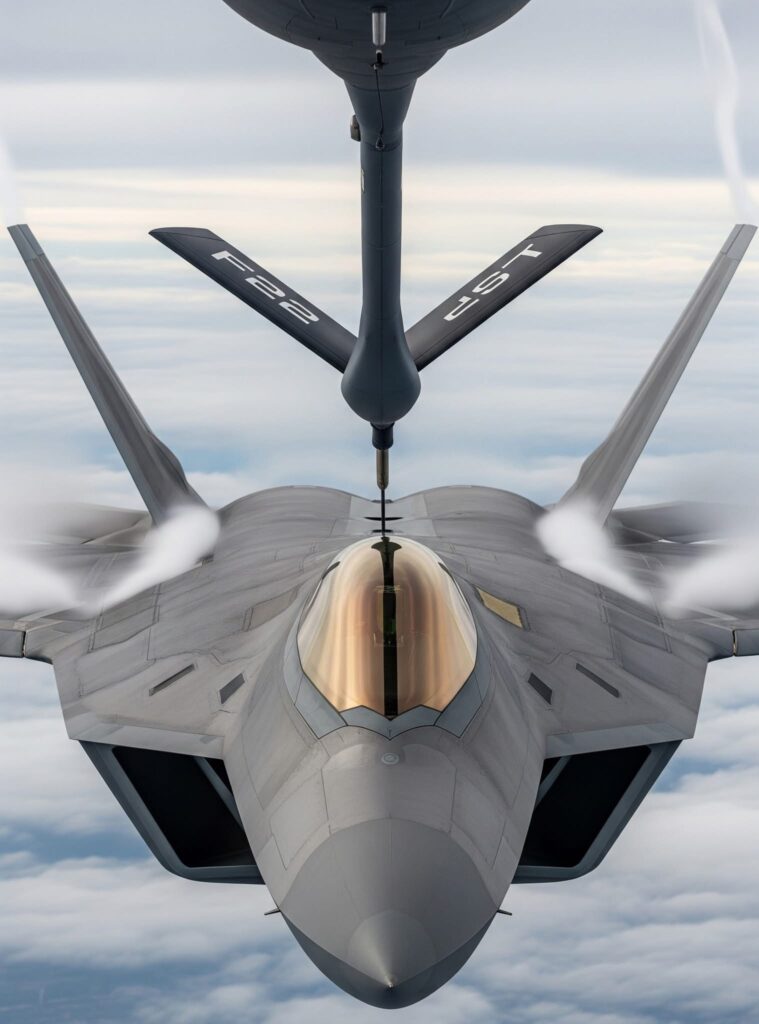
The F-22 Raptor, America’s premier fifth-generation air superiority fighter, is renowned for its stealth, speed, and unmatched maneuverability. However, like all modern fighter jets, its effectiveness depends heavily on aerial refueling. In-flight refueling ensures that the Raptor can extend its range, remain on station longer, and project power far beyond the limits of its internal fuel capacity. The process of refueling an F-22 in midair is a highly coordinated operation that combines cutting-edge technology, precision flying, and the seamless teamwork of aircrews.
Unlike many other aircraft that use a probe-and-drogue system, the F-22 is refueled via a boom system. This method requires the fighter to approach a tanker aircraft, such as the KC-135 Stratotanker or KC-46 Pegasus, which extends a rigid, telescoping refueling boom from its tail section. The Raptor pilot must carefully maneuver the jet into position directly behind and slightly below the tanker. Once aligned, the boom operator aboard the tanker guides the boom into the refueling receptacle, located on the F-22’s upper fuselage, just behind the cockpit canopy.

The placement of the receptacle is no accident. Because the F-22 is a stealth aircraft, designers carefully concealed the refueling hatch in a way that preserves the aircraft’s radar-evading shape. When closed, the hatch blends seamlessly into the Raptor’s surface, maintaining its low observable profile. During refueling, the hatch opens upward, allowing the boom to connect while minimizing aerodynamic disruption. This design is one of the many subtle but critical engineering features that distinguish the Raptor from older aircraft.
The refueling process itself demands absolute precision. Both aircraft are moving at hundreds of miles per hour, often at altitudes above 20,000 feet. Turbulence, weather conditions, and the natural airflow around the tanker can make holding a stable position challenging. The F-22 pilot must make constant micro-adjustments to keep the jet in the correct alignment with the boom. Even a small drift could disconnect the fuel line or risk contact with the tanker, which could cause serious damage. This is why aerial refueling is considered one of the most demanding skills a fighter pilot must master.

Beyond the technical challenges, aerial refueling extends the operational reach of the F-22. With refueling support, the Raptor can escort bombers, maintain combat air patrols for extended periods, or project power into regions thousands of miles away from its home base. This capability is especially important given the strategic role of the Raptor in ensuring U.S. air dominance. In conflicts where quick response times and global reach are essential, aerial refueling enables the F-22 to be where it is needed most, when it is needed most.
The sight of an F-22 sliding gracefully into position behind a tanker aircraft is more than just a routine military maneuver—it is a symbol of modern air power. It highlights the seamless integration of advanced technology and human skill, ensuring that America’s most advanced fighter never runs out of range. Refueling keeps the Raptor in the fight, ready to dominate the skies wherever the mission demands.




